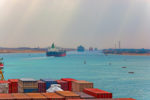
Think Tank
Maybe the World Isn't As Globalized as We Thought

That was a key finding of Ghemawat’s book, “World 3.0: Global Prosperity and How to Achieve It.” Three years later, his insight has been validated by the latest edition of the DHL Global Connectedness Index (GCI), co-authored by Ghemawat and Steven A. Altman.
The GCI, now in its third year, wasn’t meant to be a non-judgmental means of measuring cross-border integration. Its stated purpose is “analyzing global flows and their power to increase prosperity.” Still, the index offers a nuanced, realistic view of the extent to which trading nations have achieved that goal.
The report comes at the issue from several directions. It sets out to measure cross-border flows of trade, capital, information and people. And it doesn’t settle for an overly simple definition of “connectedness,” notwithstanding the danger of coining yet another economics buzzword. The term encapsulates everything from trade in goods and services to foreign direct investment, stock market activity, global internet bandwidth, volume of telephone calls and the movement of people, including migrants, tourists and international students. In all, the index measures a dozen types of flows for 140 countries that make up 95 percent of the world’s GDP and 99 percent of its population.
Nearly all of that reported activity took a steep dive following the worldwide financial crisis of 2007. At first glance, it now appears to have clawed its way back to pre-recession levels. The proportion of cross-border interactions picked up momentum in 2013 after stalling the previous year, the index found.
But that observation only scratches the surface of the issue. The findings are less positive when measured in terms of both the depth and breadth of interactions. (There’s also a third metric, directionality, which distinguishes merchandise imports from exports.) In other words, what proportion of a given type of flow is crossing national borders, as opposed to how broadly it’s distributed among partner countries?
By those measures, trade growth remains sluggish, and capital flows still haven’t recovered from their pre-crisis mark. “The overall depth of connectedness remains quite limited,” the DHL index says, “lower than many people think.”
The index for 2014 remains relatively flat because advanced economies haven’t kept up their share of activity, said Ghemawat, who is global professor of management and strategy at New York University’s Stern School of Business. In real terms, the world hasn’t fully bounced back from the recession.
Who are the leaders today? It’s no surprise to find the Netherlands at the number-one position in terms of overall globalization, given that country’s stature as a centralized distribution point for much of Western Europe. Rounding out the top five were others that play well in that market: Ireland, Singapore, Belgium and Luxembourg.
But the rankings look quite different when broken out by the depth and breadth of cross-border activity. In the former category, Hong Kong was the clear winner, while the U.K. led in the latter. And where was the U.S.? Number two in terms of breadth, but nowhere in the top ten for depth or overall globalization. (It placed 23rd out of 140 in the latter category.)
Perhaps the real story of the 2014 index is the growing strength of emerging economies. According to DHL, they are “reshaping global connectedness and are now involved in the majority of international interactions.” Prior to 2010, most cross-border flows were between advanced economies.
In fact, all 10 of the countries that saw the greatest increase in global connectedness between 2011 and 2013 were emerging economies. Where they continued to lag were in the areas of international capital, information and people flows.
Ghemawat suggested that advanced economies need to step up their game in order to keep pace with the growth of global activity. They should be tapping into more distant and developing markets, at a time when trade regionalization is on the decline. They can’t continue to depend on traditional trading partners for foreign-exchange earnings.
Why does the index matter? Traders could use the less-than-great snapshot of global activity as a spur to new investment. The so-so findings of the 2014 GCI “point us in the direction of the large headroom that exists for increased globalization,” said Ghemawat. At the same time, the index can serve to allay irrational fears of the negative impact of the trend – the phenomenon of “globaloney,” to cite a term coined by Clare Booth Luce in 1943.
Which isn’t to suggest that globalization is without its dark side. The wholesale shifting of manufacturing capacity to cheap labor sources in Asia has undoubtedly fueled unemployment and pain in the U.S. But the DHL index shows that it isn’t quite as serious as one might think, given the headlines in the general press. For example, Ghemawat said, people in surveys routinely overestimate U.S. immigration levels by a factor of two to three.
Clearly, globalization is under fire in many parts of the world. The fate of two huge free-trade pacts now under negotiation – the Trans-Pacific Partnership in the Asia-Pacific region, and the Transatlantic Trade and Investment Partnership in Europe – is in serious question. Even Ghemawat admitted to doubts about the political workability of the pacts. And the DHL index suggested that “policy fumbles or protectionist interventions” could serve as a bigger barrier to globalization that any macroeconomic fundamentals.
Still, the world economy marches on. According to Ghemawat, it’s expected to grow between 2014 and 2019 at a greater rate than it did in the 1980s, 1990s or first decade of the current century. Countries looking to prosper in the coming years had better make sure that they’re along for the ride.






